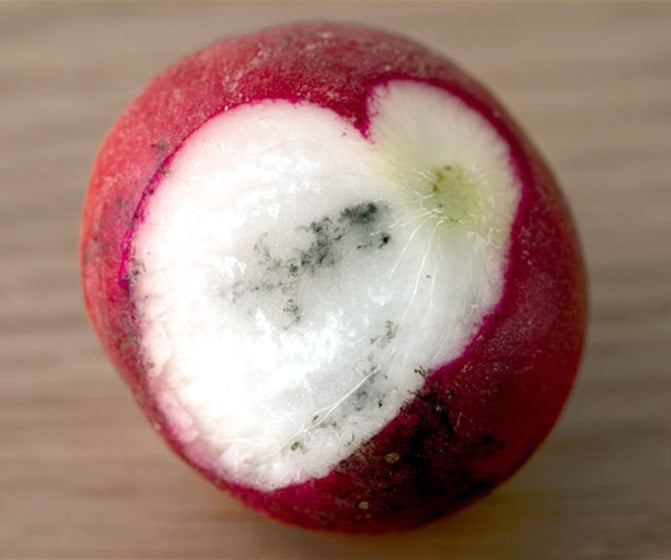So, you’ve got a bunch of radishes sitting in your fridge and you’re not quite sure if they’re still good to eat or if they’ve gone past their prime. No worries, we’ve got you covered! In this article, we’ll show you the telltale signs that your radishes have gone bad, so you can save yourself from any unpleasant surprises. From slimy textures to funky odors, these indicators will ensure that you’re not left wondering whether to toss them or give them a go. Let’s dive in and learn how to spot the not-so-fresh radishes lurking in your kitchen!

Color Changes
Yellowing Leaves
When radishes start to go bad, one of the first signs you may notice is yellowing leaves. Normally, radish leaves have a vibrant green color, so any significant yellowing is a clear indication that something is not right. The yellowing leaves could be a result of various factors, such as improper storage, age, or exposure to moisture. It’s essential to address this issue promptly, as it can lead to further deterioration of the radishes.
Browning Spots
Another color change to look out for is browning spots on the radishes. Fresh radishes have a crisp, white interior; however, if you start noticing brown spots on their surface, it’s a sign of spoilage. These spots are usually an indication of rotting, and they can spread quickly if not dealt with promptly. It’s best to discard any radishes with extensive browning spots to avoid consuming spoiled radishes.
Black or Dark Discoloration
In some cases, you may observe black or dark discoloration on radishes, particularly around the stems or tops. This could be a sign of fungal or bacterial growth, leading to spoilage. It’s crucial to differentiate between this discoloration and the normal black skin that some radish varieties naturally have. If the dark spots appear slimy or have an unpleasant odor, it’s a strong indication that the radishes have gone bad.
Texture Changes
Soft or Mushy Radishes
When you touch a radish, it should feel firm and crisp. However, if the radish feels unusually soft or mushy to the touch, it’s a clear sign of spoilage. Softness in radishes is often a result of decay or excessive moisture absorption. These texture changes occur as the radishes lose their structural integrity, making them unappetizing and possibly unsafe to consume.
Shriveling or Wrinkling
Fresh radishes have a plump and smooth texture, but when they start going bad, they begin to shrivel and develop wrinkles. This texture change could be due to dehydration, improper storage, or prolonged exposure to air. Shriveled radishes lack the characteristic crunch and juiciness of fresh radishes, often resulting in a less enjoyable eating experience.
Sliminess
If you come across slimy radishes, it’s a definite sign of spoilage. The sliminess is typically caused by bacterial or fungal growth, accelerated by excess moisture. As the radishes decompose, bacteria break down the sugars present, leading to the production of a slimy substance. The sliminess not only alters the radishes’ texture but also indicates that they are no longer safe to consume.

Smell Changes
Rotten or Foul Odor
Your sense of smell is a valuable tool in identifying spoiled radishes. Fresh radishes have a mildly peppery scent, but as they go bad, their odor can quickly shift to a rotten or foul smell. If you detect an unpleasant or pungent aroma emanating from your radishes, it’s a clear indication that they have deteriorated. It’s advisable to discard radishes with a strong, off-putting smell to avoid any risk of foodborne illness.
Mold Growth
Fuzzy Mold
The presence of fuzzy mold on radishes is a sure sign that they have reached an advanced stage of spoilage. Mold thrives in warm and moist environments, and radishes that have not been stored correctly can easily become a breeding ground for mold. This fuzzy growth can appear in various colors, including white, green, or even black. It’s important to note that while some molds on radishes are harmless, others can produce mycotoxins that are toxic to humans. Therefore, it’s best to discard moldy radishes to ensure your safety.
Black Spots
Black spots on radishes can indicate the development of mold as well. These spots often occur where the radish has been bruised or damaged, providing a starting point for fungal growth. As the mold spreads, the black spots can increase in size and become more prominent. Not only do these spots affect the radishes’ appearance, but they can also compromise their taste and overall quality.

Excessive Moisture
Damp or Wet Radishes
When radishes are exposed to excessive moisture, they can quickly become damp or wet. This excess moisture can lead to a host of issues, including decay, mold growth, and loss of crispness. If you notice that your radishes feel wet or have condensation on their surface, it’s a sign that they have not been stored properly or have been subjected to high humidity levels. Consuming damp radishes is not recommended, as they are likely to have a shortened shelf life and compromised quality.
Puddles or Pooling Water
Discovering puddles or pooling water near your radishes is a clear indication of excessive moisture. Whether it’s due to improper storage or a leak in the packaging, standing water creates a breeding ground for bacteria and mold. Radishes submerged in water can quickly become waterlogged and lose their desired texture and taste. If you come across radishes surrounded by pools of water, it’s safest to discard them and prevent any potential health risks.
Unpleasant Taste
Bitterness
While radishes naturally possess a slightly peppery taste, if you bite into a radish and it tastes overly bitter, it’s a sign that it has gone bad. The bitterness can result from the breakdown of cell walls in the radish, allowing bitter compounds to develop. Consuming bitter radishes is not only unappetizing, but it can also be an indicator of the presence of harmful bacteria or fungi.
Sourness
Fresh radishes have a crisp, refreshing flavor, but if you notice a sour taste when consuming a radish, it’s a clear indication of spoilage. The sourness can be a result of fermentation, which occurs when bacteria or yeast break down the sugars in the radish, producing acids. This process can significantly alter the taste profile of the radishes and render them unpalatable.
Off or Stale Flavor
Spoiled radishes can develop an off or stale flavor that is distinctly different from their fresh, vibrant taste. This flavor change can occur due to various factors, including bacterial or fungal growth, improper storage, or age. If your radishes have lost their characteristic crunch and have an unusual or unpleasant taste, it’s best to discard them and opt for fresh radishes instead.

Root Disintegration
Easily Breakable
When radishes start to spoil, their roots often become weak and fragile, leading to easy breakability. Instead of a robust and solid root, you may find that the radishes crumble or break apart with minimal force. The disintegration of the root indicates that the radishes have reached an advanced stage of decay and are no longer suitable for consumption.
Disintegrating Roots
In severe cases of radish spoilage, the roots can completely disintegrate, leaving behind an unappetizing mush. The disintegration of the roots is a result of the breakdown of the radish’s cellular structure, rendering it inedible. If you come across radishes with disintegrated roots, it’s crucial to discard them promptly to prevent any potential health risks or unpleasant eating experiences.
Signs of Pests
Holes or Tunneling
Pests can wreak havoc on radishes, leaving distinct signs of their presence. One of the most obvious signs is the appearance of holes or tunneling on the radishes’ surface. Common culprits could be insects like wireworms, maggots, or other types of larvae. These pests feed on the radishes, causing damage to their structure and compromising their overall quality. If you notice extensive holes or tunneling, it’s advisable to discard the affected radishes.
Bite Marks
Another sign of pest infestation is the presence of bite marks on radishes. These bite marks typically occur when animals like rodents, rabbits, or insects nibble on the radishes. The appearance of bite marks not only affects the radishes’ aesthetic appeal but also indicates that they have been compromised and may no longer be safe to eat. It’s essential to sanitize the storage area and take measures to prevent further pest infestation.

Wilting or Drooping Tops
Limp or Withered Greens
The tops or greens of radishes are an excellent indicator of their freshness. Fresh radishes have vibrant, crisp greens that stand upright. However, when radishes start to go bad, their tops can wilt or droop. This wilting is due to moisture loss and deterioration of the radish’s internal structure. Limp or withered greens are not only unappealing but also suggest that the radishes are past their prime and should be discarded.
Expiration Date
Expired or Long Past Shelf Life
Lastly, if you find that your radishes are past their expiration date or have been sitting for an extended period, it’s highly likely that they have gone bad. Radishes, like any other perishable vegetable, have a limited shelf life. As they age, their quality deteriorates, resulting in changes in color, texture, smell, and taste. It’s important to check the expiration date on the packaging and consume radishes within the recommended timeframe to enjoy them at their freshest. Once radishes are past their shelf life, it’s advisable to discard them and opt for fresh radishes instead.
In conclusion, recognizing the signs of spoilage in radishes is crucial to ensure your safety and enjoyment of this crisp and nutritious vegetable. From color changes to texture changes, smell changes, mold growth, excessive moisture, unpleasant taste, root disintegration, signs of pests, wilting tops, and expiration dates – paying attention to these indicators will help you determine when your radishes have gone bad. By promptly identifying spoilt radishes, you can avoid consuming unsafe or unappetizing produce and instead opt for fresh and delicious radishes to complement your meals. Remember, when it comes to radishes, freshness is key!



